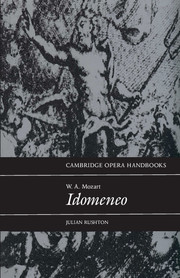Book contents
- Frontmatter
- Contents
- List of illustrations
- General preface
- Acknowledgements
- Introdution
- 1 Synopsis
- 2 Genesis of an operone
- 3 ‘Madame Dorothea Wendling is arcicontentissima’: the performers of Idomeneo
- 4 The genre of Idomeneo
- 5 From myth to libretto
- 6 Idomeneo after Mozart
- 7 General structure of Idomeneo
- 8 Two soliloquies
- 9 The musical language of Idomeneo
- 10 Tonality and motive
- 11 Elettra's first aria and the storm scene
- 12 Conclusions
- Notes
- Select bibliography
- Index
- Plate section
4 - The genre of Idomeneo
Published online by Cambridge University Press: 05 June 2012
- Frontmatter
- Contents
- List of illustrations
- General preface
- Acknowledgements
- Introdution
- 1 Synopsis
- 2 Genesis of an operone
- 3 ‘Madame Dorothea Wendling is arcicontentissima’: the performers of Idomeneo
- 4 The genre of Idomeneo
- 5 From myth to libretto
- 6 Idomeneo after Mozart
- 7 General structure of Idomeneo
- 8 Two soliloquies
- 9 The musical language of Idomeneo
- 10 Tonality and motive
- 11 Elettra's first aria and the storm scene
- 12 Conclusions
- Notes
- Select bibliography
- Index
- Plate section
Summary
Idomeneo is conveniently referred to in most critical discussions as an opera seria. Serious it undoubtedly is; but the genre usually understood by opera seria - that against which Gluck and Calzabigi reacted in the dedicatory preface to Alceste: a genre consisting mainly of arias, dominated by the singers as much as by the composer and poet - does not supply the framework of Idomeneo or even the background from which it departs.
The subtitle on the libretto is ‘Dramma per musica’, a conventional designation obviously appropriate to a translated tragédie lyrique with a happy ending (the designation opera seria is in any case comparatively rare in the eighteenth century). ‘Dramma per musica’ has overtones of very early opera; of this, Mozart certainly knew nothing. He himself referred to Idomeneo as ‘grosse Opera’, a term he does not define, of course, but which he also applied to Holzbauer's Günther von Schwarzburg. Ten years later he called Metastasio's La clemenza di Tito ‘opera seria’ in his personal catalogue, which suggests an understanding of the genre close to the definition offered above. Mozart added that for him La clemenza has been ‘turned into a real opera’. Its departure from Metastasio takes it closer, but not very close, to Idomeneo.
Mozart was well acquainted with the forms and topics of opera seria. Before he went to Italy, he met in London one of its leading German exponents, J. C. Bach, who later composed operas for Mannheim and Paris. Mozart's own youthful improvisations in opera seria style were described by Daines Barrington.
- Type
- Chapter
- Information
- W. A. Mozart: Idomeneo , pp. 62 - 68Publisher: Cambridge University PressPrint publication year: 1993



